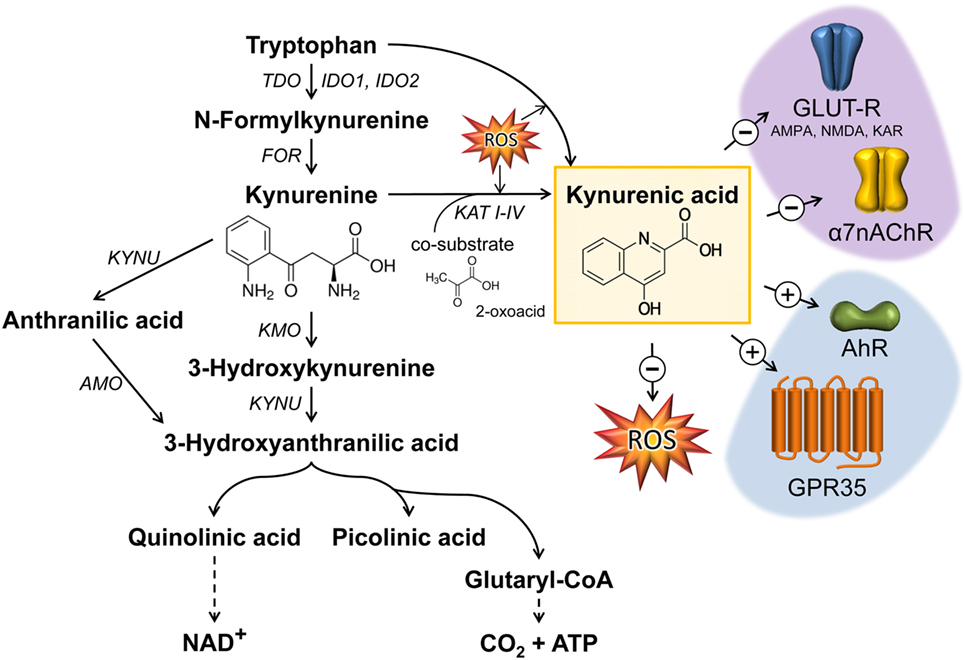Germain et al påviste lavt niveau af L-kynurenine / Formyl-5-hydroxykynurenamine i plasma fra ME patienter (2).
Kynurenine (KYN) kan omdannes til kynurenic acid (KYNA), på dansk kynureninsyre. Vi kan formode, at flere kynurenine metabolitter er påvirkede hos ME patienter - både i inde i cellerne, i plasma og i cerebrospinalvæsken. Så forhåbentlig er der forskere i gang med at bestemme niveauet af disse metabolitter, og hvad det kan betyde for ME sygdomsmekanismen. I mellemtiden kan vi læse om de enkelte metabolitters betydning for kroppen.
KYNA er en vigtig metabolit, der udøver immundæmpende effekt via GPR35- og AhR-associerede stiveje (3):

Figure 1. Kynurenic acid (KYNA) synthesis along the kynurenine pathway and its mode of action. The catabolism of TRP by the enzymes TDO or IDO represents the rate-limiting step in KYNA synthesis. The intermediate metabolite kynurenine can be further processed through three distinct pathways to form KYNA, 3-hydroxykynurenine, and anthranilic acid. KYNA is formed by the irreversible transamination of KYN either via kynurenine aminotransferases (KAT I–IV) or through the action of reactive oxygen species (ROS). KYNA is a non-competitive antagonist of ionotropic glutamate receptors (GLUT-R) as well as of the α7 nicotinic acetylcholine receptor (α7nAChR) expressed on neuronal cells. Apart from neuromodulatory properties, KYNA is an agonist of the broadly expressed G-protein-coupled receptor 35 (GPR35) and aryl hydrocarbon receptor (AhR). Furthermore, KYNA functions as an ROS scavenger. Black arrows mark enzymatic reactions and dashed arrows include more than one catalytic reaction step. FOR, formamidase; IDO, indolamine 2,3-dioxygenase; TDO, tryptophan 2,3-dioxygenase; TPH, tryptophan hydroxylase; KAT, kynurenine aminotransferase; KMO, kynurenine 3-monooxygenase; KYN, kynureninase; AMO, anthranilate 3-monooxygenase; AMPA, α-amino-3-hydroxy-5-methyl-4-isoxazolepropionic acid receptor; NMDA, N-methyl-d-aspartate receptor; KAR, kainate receptor.
Figuren er fra ref 3: Wirthgen et al (2018). Jeg kan varmt anbefale, at man læser hele artiklen.
Referencer:
1) ME hypotese: The Metabolic Trap - den metaboliske fælde2) Germain et al: Metabolic profiling of a ME/CFS discovery cohort reveals disturbances in fatty acid and lipid metabolism. Mol. BioSyst. 2017, 13, 371 https://pubs.rsc.org/en/Content/ArticleLanding/2017/MB/C6MB00600K#!divAbstract
Front Immunol. 2018 Jan 10;8:1957. doi: 10.3389/fimmu.2017.01957. eCollection 2017.
https://www.frontiersin.org/articles/10.3389/fimmu.2017.01957/full
Ingen kommentarer:
Send en kommentar
Bemærk! Kun medlemmer af denne blog kan sende kommentarer.